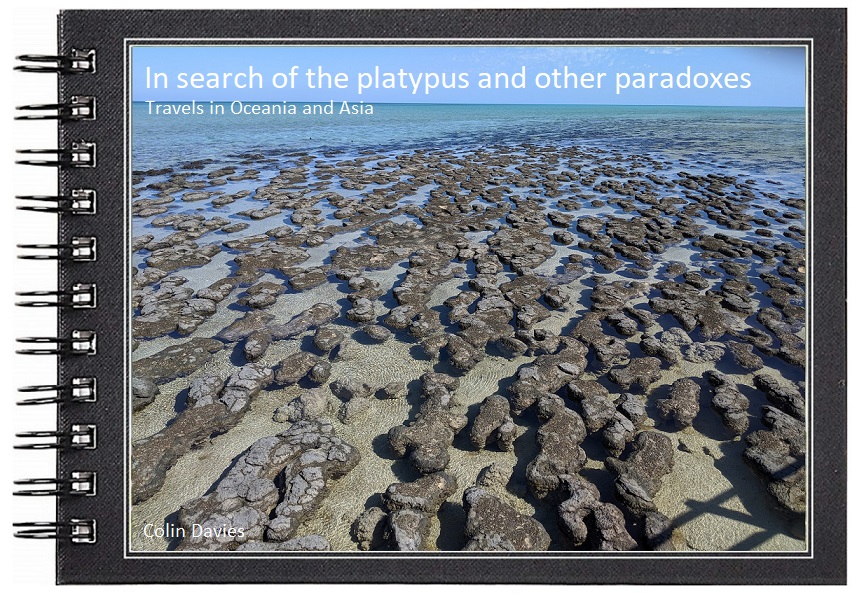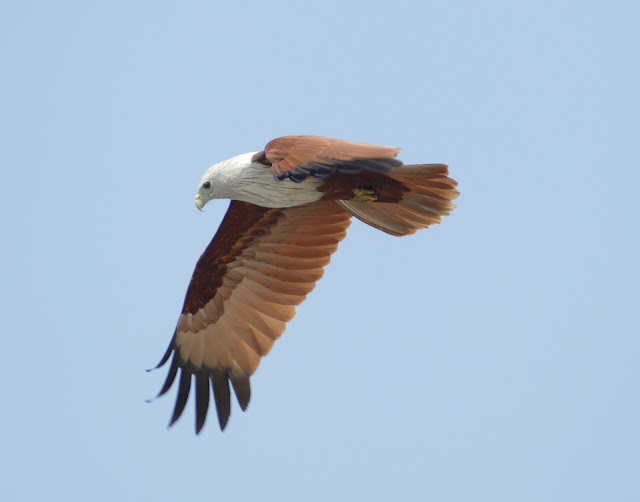Today we visited the wonderful Changaram wetlands just south of Kochi. What a
place it is, masses of birds on the lilypad covered flooded fields, with
people working waist deep in the water, a really evocative scene. One of the
many highlights was the large numbers of cotton pygmy geese, a delightful
little duck which I have seen before near Brisbane, but not as well or in such
numbers.
Other species included lesser whistling ducks, 100 garganey, stork-billed
kingfisher, red-wattled lapwing, oriental darter, Indian cormorant, ashy
woodswallow, blue-tailed bee-eaters, grey-headed swamphens, ashy prinia,
pheasant-tailed jacana (unfortunately in non-breeding plumage), bronze-winged
jacana, clamerous reed warbler, brown-headed gull, black-winged stilts,
spot-billed pelican and various egrets and herons such as intermediate egret
and purple heron.
Cotton pygmy geese Nettapus coromandelianus are the smallest of
all wildfowl, smaller even than teal. They are true ducks and not geese,
despite their name and looks. Actually this is a different race to those I
have seen in Brisbane which are sometime called Australian pygmy goose
N.c. albipennis. Perhaps unsurprisingly these birds in India are
sometimes known as Indian pygmy goose
N.c. coromandelianus, though their range does extend into south
east Asia. In Australia I also saw another species, green pygmy goose.
You really can see how small these cotton pygmy geese are when you realise
that on the extreme right of this photo there are two garganey which look
bigger and stockier.
Cotton pygmy geese.
We asked a couple of these people what they were doing and apparently they
were gathering food for the cattle, though the cattle themselves were often
deep in the water and seemed well capable of getting food without help.
I remember as if it was yesterday the excitement of seeing my first purple
gallinule at Ludo Lagoon on the Algarve, Portugal in 1992. I got up at first
light and drove to a rickety hide on stilts overlooking a lagoon surrounded
by reeds in the middle of Ria Formosa. To get into the hide I had to climb
up a metal ladder and then enter through a trap door and I could feel the
hide swaying as I entered it. On closing the trap door and opening the
window I found that there was a mist over the lagoon which was packed with
coots, gadwall and mallard and suddenly I saw a large dark bird fly across
the water and crash into the reeds on the other side. Later I saw another
eating reeds by holding them in its ridiculous feet. At the time that seemed
a remarkable sighting of a species which I thought of as the holy grail of
European birding, and a bird which I thought would be very skulking and
difficult to see. Two days later that myth was exploded when I found another
three walking on the greens of a golf course at Vilamoura, and ever since
then I've done very well for the species, even seeing one in the UK in
2016.
The hide at Ludo is sadly now long gone and I don't imagine that anybody
goes there these days specifically for purple gallinule because they can be
seen far more easily in many other places. Even the name purple gallinule
has gone, it's been split into several species with western swamphen now the
preferred name for the European birds. In Australia and New Zealand I've
seen many Australian swamphens, which are also known as Pukeko in
Moari.
So today it was great to catch up with a third species of "purple
gallinule", grey-headed swamphen, in a location which if anything is even
more evocative than Ludo. This species occurs throughout India and
south-east Asia, but also the Middle East and indeed I saw grey-headed
swamphen in Kuwait a few days ago.
Grey-headed swamphen has itself been split into three races with those in India Porphyrio poliocephalus poliocephalus. The birds I saw in Kuwait were a different race, P. p. seistanicus.
Blue-tailed bee-eater.
Bronze-winged jacana.
Brown-headed gulls, in many ways very similar to black-headed gulls except
note that the wing pattern is very different in the flying adult on the
right of the photo. Black-headed gulls do occur in India, and in fact there's one on the extreme right of the standing birds in this photograph. See how much smaller it is.
Clamerous reed warbler.
Indian cormorant.
Indian pond heron.
Intermediate egret.
Lesser whistling ducks.
Oriental darter with Indian cormorants.
Purple heron.
Red-wattled lapwing.
Stork-billed kingfisher.
Ashy prinia.
Ashy prinia.


































No comments:
Post a Comment